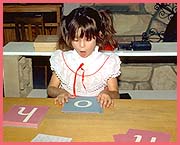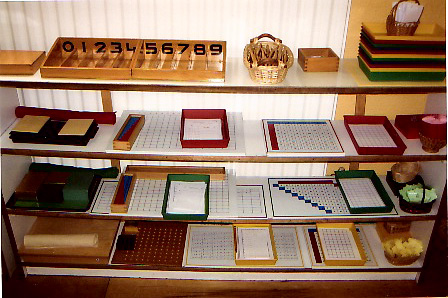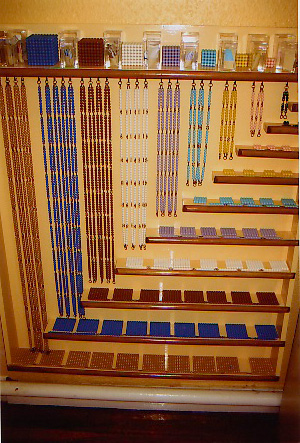Sensorial comes from the words sense or senses. As there are no new experiences for the child to take from the Sensorial work, the child is able to concentrate on the refinement of all his senses, from visual to stereognostic.
The purpose and aim of Sensorial work is for the child to acquire clear, conscious, information and to be able to then make classifications in his environment. Montessori believed that sensorial experiences began at birth. Through his senses, the child studies his environment. Through this study, the child then begins to understand his environment. The child, to Montessori, is a “sensorial explorer”.
Through work with the sensorial materials, the child is given the keys to classifying the things around him, which leads to the child making his own experiences in his environment. Through the classification, the child is also offered the first steps in organizing his intelligence, which then leads to his adapting to his environment.
Sensorial Exercises were designed by Montessori to cover every quality that can be perceived by the senses such as size, shape, composition, texture, loudness or softness, matching, weight, temperature, etc. Because the Exercises cover such a wide range of senses, Montessori categorized the Exercises into eight different groups: Visual, Tactile, Baric, Thermic, Auditory, Olfactory, Gustatory, and Stereognostic.
In the Visual Sense Exercises, the child learns how to visually discriminate differences between similar objects and differing objects.
In the Tactile Sense Exercises, the child learns through his sense of touch. “Although the sense of touch is spread throughout the surface of the body, the Exercises given to the children are limited to the tips of the fingers, and particularly, to those of the right hand.” (Montessori, Maria (1997) The Discovery of the Child, Oxford, England: Clio Press) This allows the child to really focus on what he is feeling, through a concentration of a small part of his body.
In the Baric sense Exercises, the child learns to feel the difference of pressure or weight of different objects. This sense is heightened through the use of a blindfold or of closing your eyes.
In the Thermic Sense Exercises, the child works to refine his sense of temperature.
In the Auditory Sense Exercises, the child discriminates between different sounds. In doing these different Exercises, the child will refine and make him more sensitive to the sounds in his environment.
In the Olfactory and Gustatory Sense Exercises, the child is given a key to his smelling and tasting sense. Although not all smells or tastes are given to the child in these Exercises, the child does work to distinguish one smell from another or one taste from another. He can then take these senses, and apply them to other smells or tastes in his environment.
In the Stereognostic Sense Exercises, the child learns to feel objects and make recognitions based on what he feels. “When the hand and arm are moved about an object, an impression of movement is added to that touch. Such an impression is attributed to a special, sixth sense, which is called a muscular sense, and which permits many impressions to be stored in a “muscular memory”, which recalls movements that have been made."((Montessori, Maria (1997) The Discovery of the Child, Oxford, England: Clio Press)
Montessori’s materials for the Sensorial work came from her own observations and from ideas and materials from the French doctors Itard and Seguin. Unlike the material used for Practical Life, this material has either never been seen or never been used by the child in his everyday life. With this said however, the child will receive no new experiences through the use of the material. This was purposefully thought through in order to give the child what he knows, but might not yet realize, and to then refine his knowledge. In order to do this, the material is presented in a specific way or in a specific pattern: the child learns to match the similar things, then he is shown how to grade the material based on its quality, and then he receives the language related to his work. In presenting the material to the child in this way allows him to fully understand the concept of his work.
All of the Sensorial materials were designed keeping the same ideas in mind.
- All of the material isolates the one quality that is to be worked with by the child. This allows the child to focus on that one quality.
- All of the materials have, what is called, a control of error. This calls to the child to make the corrections himself.
- All of the material is esthetically pleasing. Such as with the Practical Life materials, this attracts the child’s attention to the objects and allows the child to manipulate the materials with ease.
- All of the material must be complete. This allows the child who is working with the material to finish through the entire piece of work without having to stop and find a missing piece.
- All of the material is limited. The first use of the term limited refers to the fact that there is only one of each material in the environment. This calls for other students to build on their patience. The second use of the word limited is in reference to the idea that not all of one quality or piece of information is given to the child. This child is not given every color in the world, but only a select few. This gives the child the keys to the information so it peaks his curiosity and leads him to learn more out of his own interest.
- Most importantly, all of the material could be called “materialized abstractions”. This means that though Montessori’s Sensorial materials, abstract concepts are made into concrete materials.
Montessori saw the importance of the manipulation of objects to aid the child in better understanding his environment. Through the child’s work with Sensorial material, the child is helped to make abstractions, he is helped in making distinctions in his environment, and the child is given the knowledge not through word of mouth, but through his own experiences.
The Three Period Lesson is to be given after the child has had much experience with the material itself. The reason behind the Three Period Lesson is to give the language of the material the child has been using. It is meant to teach the names of objects and the names of the qualities of theses materials. The Three Period Lesson is divided into three steps, so the language will be more easily absorbed. There is the Three Period Lesson for naming an object, and for grading an object positively, comparatively, and superlatively.
The directress presents the child with three objects of contrast and isolates them on a mat. The directress then experiences the objects one at a time by feeling the object thoroughly. Then the directress will encourage the child to experience all three of the objects. The directress will look the child in the eyes and clearly give the name of one of the objects. For example, “This is an ovoid.” Then the directress will repeat the naming for the other two objects. Then the directress will repeat the names of each of the objects.
Once the child has clearly heard the names of each of the objects more than once, the directress will now challenge the child to recognize the objects by their names. To do so, the directress will ask the child to do something with the object she names. For example, “Please place the ovoid in my hand.” Or another example could be, “Please place the ovoid here…”
The child should then move to the correct object the directress has just asked for. By doing this step, the child will be putting the names of the objects into his long-term memory.
Once the child has successfully placed the names of the objects into his long-term momory, the directress will challenge the child to name the objects himself. This will ask for the child to associate the name of the object to the object itself. For example the directress might point to one of the objects and ask: “What is this?” The child should then respond, for example, “This is an ovoid.”
The directress places two objects of a group and isolates them on a mat. (For example, a long rod and a short rod.) The directress then experiences the two objects one at a time by feeling the object thoroughly. Then the directress will encourage the child to experience both of the objects. The directress will look the child in the eyes and clearly give the names of the difference of the two objects. For example, “This is the long rod.” And for the other object, “This is the short rod.” Repeat this but replace one of the objects with an object different as to the one taken out. For example if you are grading rods, the directress could take out the short rod and replace it with a shorter rod. Then, what was the short rod becomes the long rod and the new rod becomes the short rod. This way the child understands that the grading of an object depends on what it is being graded to.
Just as in Step 2 for the Three Period Lesson for Naming, the directress will then have the child match the object to the name. For example, the directress might say, “Please give me the short rod.” Or she may say, “Please place the long rod here.”
Just as in Step 3 for the Three Period Lesson for Naming, the directress will ask the child, “What is this?” The child should then answer, for example, “This is the short rod”.
The directress places two objects of a group and isolates them on a mat. (For example, two shades of the blue color tablets.) The directress will look the child in the eyes and clearly give the names of the difference of the two objects. For example, “This is dark.” And for the other object, “This is darker.” Repeat this but replace one of the objects with an object different as to the one taken out. For example if you are grading the color tablets, the directress could take out a darker blue than before. Then, what was the darker becomes the dark and the new tablet becomes the darker. This way the child understands that the grading of an object depends on what it is being graded to.
Same as Step 2 of above but this time the directress will ask the child, “ Which one is the darker tablet?” Or, “Which one is the dark tablet?”
Same as Step 3 of above: “What is this?”
The directress places three objects of a group and isolates them on a mat. For example, three shades of the yellow color tablets. (Remember: this is not limited to three objects.) The directress will look the child in the eyes and clearly give the names of the difference of the two objects. For example, “This is dark.” And for the second object, “This is darker.” And for the third object, “This is darkest.” Repeat this but replace one or two of the objects with objects different as to the ones taken out. For example if you are grading the color tablets, the directress could take out a darker yellow than the darkest and a lighter color than the dark tablet. Then, what was the darkest becomes the darker and the dark becomes the darker. This way the child understands that the grading of an object depends on what it is being graded to.
Same as Step 2 of above but this time the directress will ask the child, “ Which one is the darker?” Or, “Which one is the dark?” Or, “Which one is the darkest?”
Same as Step 3 of above: “What is this?”
www.infomontessori.com






 Little children are naturally attracted to the science of number. Mathematics, like language, is the product of the human intellect.
Little children are naturally attracted to the science of number. Mathematics, like language, is the product of the human intellect.  The mathematical material gives the child his own mathematical experience and to arrive at individual work. There are some teacher directed activities but these are followed with activities for the individual. Some work begins with small group lessons, these too will be toward independent, individual work.
The mathematical material gives the child his own mathematical experience and to arrive at individual work. There are some teacher directed activities but these are followed with activities for the individual. Some work begins with small group lessons, these too will be toward independent, individual work.  In the prepared environment, there is a variety of activity as well as a great deal of movement. In a
In the prepared environment, there is a variety of activity as well as a great deal of movement. In a  The materials themselves invite activity. There are bright arrays of solid geometric forms, knobbed puzzle maps, colored beads, and various specialized rods and blocks.
The materials themselves invite activity. There are bright arrays of solid geometric forms, knobbed puzzle maps, colored beads, and various specialized rods and blocks.











